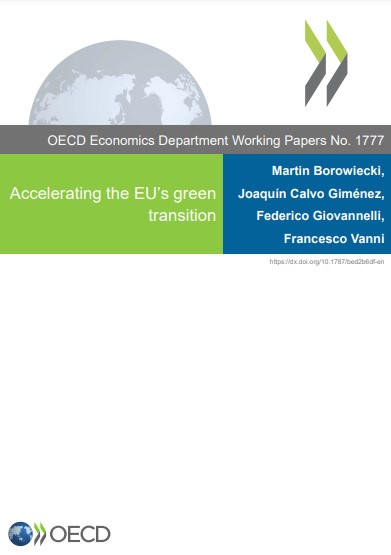목차
Title page
Contents
Abstract 4
Introduction 7
Progress towards net zero 7
The EU's climate mitigation policies 9
Towards more efficient mitigation policies 18
Free allowances reduce the effectiveness of carbon pricing 19
Strengthen carbon markets for sectors not covered by the ETS 21
Effective carbon rates vary across countries and sectors 21
An internal carbon price can improve efficiency of public spending 22
Making financial markets work for the green transition 23
Targeting mitigation policies to sectors 27
Ramping up mitigation in agriculture 27
Accelerating the energy transition 35
Bringing down emissions in transportation 44
Limiting reallocation costs from the green transition 48
References 54
Table 0.1. Economic effects of EU 'Fit for 55' policies in 2030 14
Table 0.2. Economic effects of EU 'Fit for 55' policies in 2030, by country 15
Table 0.3. Recommendations 53
Figure 0.1. Reductions in greenhouse gas emissions need to accelerate 8
Figure 0.2. Energy, transport, and agriculture account for a large share of emissions 9
Figure 0.3. The ETS price has risen recently 11
Figure 0.4. Biomass accounts for a large share of renewable energy supply 16
Figure 0.5. Fossil fuels benefit from a favourable tax treatment 18
Figure 0.6. The effective carbon price is relatively high 20
Figure 0.7. Carbon pricing differs considerably across sectors and countries 22
Figure 0.8. Capital markets are less developed than in peer economies 26
Figure 0.9. Venture capital remains relatively low 27
Figure 0.10. Agricultural emission reductions have stalled 28
Figure 0.11. The effective carbon price in agriculture is relatively low 30
Figure 0.12. Agricultural income support remains high despite a growing trade surplus 33
Figure 0.13. Energy consumption remains heavily reliant on fossil fuels 35
Figure 0.14. Government support for renewables remains high and mostly benefits solar and wind 36
Figure 0.15. Lengthy permitting processes slow down the deployment of renewables 38
Figure 0.16. Retail prices for electricity differ across EU countries 41
Figure 0.17. Cars are the main source of emissions in the transport sector 45
Figure 0.18. The carbon-intensity of electric cars depends on the electricity mix of the country of production 47
Figure 0.19. Vacancies and wage premia in green jobs are high 48
Figure 0.20. Labour market churn is low on average 50
Figure 0.21. Occupational entry barriers remain high 51
Boxes
Box 0.1. The EU's new climate mitigation policies 9
Box 0.2. A Computable General Equilibrium analysis of the economic effects of the EU's 'Fit for 55' policies 13
Box 0.3. The EU's Carbon Border Adjustment Mechanism 20
Box 0.4. Green budgeting across the OECD 24
Box 0.5. The EU's Common Agricultural Policy and climate action 29
Box 0.6. New Zealand's approach to carbon pricing in agriculture 31
Box 0.7. The new Common Agricultural Policy 2023-27 34
Box 0.8. US Inflation Reduction Act 37
Box 0.9. The European Commission's proposal for a reform of the EU electricity market 40
Box 0.10. Policy support for carbon capture and storage 43
Box 0.11. EU Emission Trading System for buildings and road transport (ETS 2) 46
Box 0.12. Just Transition Mechanism and Social Climate Fund 52
해시태그
관련자료
AI 100자 요약·번역서비스
인공지능이 자동으로 요약·번역한 내용입니다.




